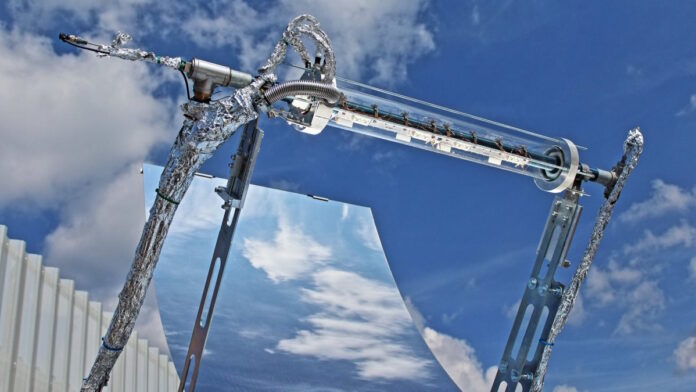
Solar rays focused on concentrator photovoltaic cells using parabolic mirrors not only supply electricity, but also thermal energy for industrial processes, heating or cooling. Three technological innovations significantly reduce costs.
An international team, led by Armin Buchroithner, from the Institute of Electrical Measurement and Sensor Systems at Graz University of Technology (TU Graz), has developed a parabolic trough collector with cost-effective photovoltaic cells that can be used to generate solar power and thermal energy at the same time.
The solar module consists of a trough-shaped concave mirror that focuses the sun’s rays onto the photovoltaic cells arranged in the focal line. The waste heat from the solar cells is transferred to a heat transfer fluid that flows along the back of the cells in a system of pipes. The thermal and electrical energy generated in this way can, for example, be used for climate-neutral heating and cooling of buildings or for industrial purposes, such as in the food or textile industry.
The idea of generating electricity and heat from solar radiation at the same time has been around since the 1970s, but has not been successful due to high costs and technological problems. This could now change, as Buchroithner’s team has succeeded in developing several technological innovations in the course of the ECOSun – Economic COgeneration by Efficiently COncentrated SUNlight research project.
Solar radiation amplified
In cooperation with partner IMK Solarmirrotec, the parabolic trough collectors were manufactured more efficiently, using industrial production methods such as injection moulding technology. The silicon solar cells developed with the Turkish research centre GÜNAM are cost-effective and robust, and can withstand the high temperatures of concentrated sunlight. This is an important factor, since the parabolic trough mirrors amplify the solar irradiation by a factor of 60 to 120. The researchers were also able to optimise the cooling of the solar cells, making the waste heat more usable for further applications.
“This approach has the potential to make a significant contribution to the energy transition,” said Buchroithner.
So far, parabolic trough solar power plants have been located almost exclusively in particularly sunny regions such as Spain or the Persian Gulf.
“However, our tests have shown that it can also be useful here in Austria or other regions to replace fossil fuels in industrial processes,” Buchroithner added.
“Given the rising energy prices and the desire for energy independence, the importance of independent, efficient, and cost-effective solutions for the supply of electricity and heat is increasing.”
In addition to TU Graz, the ECOSun research consortium includes the Center for Solar Energy Research and Application in Ankara, the Heat and Mass Transfer Technological Centre of the Universitat Politècnica de Catalunya in Barcelona and the industrial partners IMK GmbH Solarmirrortec from Seitenstetten and iTech Solar from Ankara. The research project was funded in equal parts by the Austrian Research Promotion Agency and the European Union within the SOLAR-ERA.NET Cofund programme.
Jim Cornall is editor of Deeptech Digest and publisher at Ayr Coastal Media. He is an award-winning writer, editor, photographer, broadcaster, designer and author. Contact Jim here.




